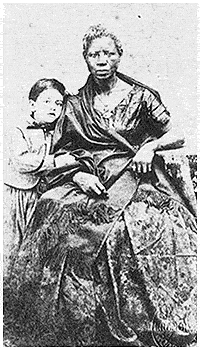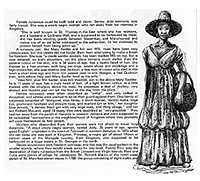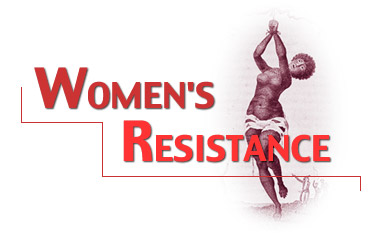"One muffled strain . . . a jarring chord and a vague and uncomprehended cadenza has been and still is the Negro. And of that muffled chord, the one mute and voiceless note has been the sadly expectant Black Woman." Rhythmic in prose and melodic in tone, this quote nevertheless rings true with the harsh plight of black slave women. The enslaved African woman has too often disappeared from historical accounts of slavery. Whether historians assumed that she had nothing important to say about the harsh conditions of her enslavement, or that her reactions to the daily humiliations that she suffered were the same as those of her male slave counterpart, her wants, needs, opinions, struggles, and triumphs went unheard. The enslaved African woman received little or no credit for taking an active role in resistance to slavery.
Yet enslaved women took part in every important fight against slavery. Slave women courageous ly fought against the restrictive bonds of slavery. However, they did so in their own distinctive ways. Historians have valorized the more often violent or forceful acts of resistance attributed to black male slaves. But women’s individualized means of resistance to slavery, such as poisoning the master or members of his family, abortions or infanticide, have too often been ignored. Literally and figuratively, she was silenced for, "as our Caucasian barristers are not to blame if they cannot quite put themselves in the dark man’s place, neither should the dark man be wholly expected fully and adequately to reproduce the exact Voice of the Black Woman." In "The History of Mary Prince, A West Indian Slave. Related by Herself," one can hear the enslaved Caribbean woman’s voice "in her own write." In her history, she is the unquestionable authority in the telling of her story. She is the one defining herself. Here, at last, we can see some of the ways in which enslaved women resisted the unrelenting bonds of slavery within her enforced domestic, social, and economic role in Caribbean slave society. ly fought against the restrictive bonds of slavery. However, they did so in their own distinctive ways. Historians have valorized the more often violent or forceful acts of resistance attributed to black male slaves. But women’s individualized means of resistance to slavery, such as poisoning the master or members of his family, abortions or infanticide, have too often been ignored. Literally and figuratively, she was silenced for, "as our Caucasian barristers are not to blame if they cannot quite put themselves in the dark man’s place, neither should the dark man be wholly expected fully and adequately to reproduce the exact Voice of the Black Woman." In "The History of Mary Prince, A West Indian Slave. Related by Herself," one can hear the enslaved Caribbean woman’s voice "in her own write." In her history, she is the unquestionable authority in the telling of her story. She is the one defining herself. Here, at last, we can see some of the ways in which enslaved women resisted the unrelenting bonds of slavery within her enforced domestic, social, and economic role in Caribbean slave society.
In order to tell the story of a slave, a person must experience what it truly means to be enslaved. Even though Mary Prince was born to slave parents in Bermuda, she would never have been able to tell such a powerful story, had she not experienced for herself the harshest conditions of slavery. At first, Prince seemed to be among the favored few who would escape such a plight. Purchased and made the "pet" of a Miss Betsey Williams, the only daughter of her owners, Mary "was [at first] too young to understand rightly her condition as a slave." Prince gave her cheerful obedience to Mrs. Williams because the white woman showed affection towards her. This form of obedience was not a result of the "fear of the power which the white people’s law had given her [Mrs. Williams] above me."
Prince’s trust in whites and her attitude towards their treatment of slaves did not last for long, though. Not long after turning twelve, Prince learnt for herself that even though not all whites were innately bad people, "slavery hardens white people’s hearts towards the blacks." After the death of Mrs. Williams, Mr. Williams sold Mary and two of her sisters in order to raise money for the wedding expenses of his impending marriage to his new bride. He carelessly separated Mary and her sisters from their mother, father, and little brothers, despite the fact that they had been bought for Miss Betsey. Mary’s mother herself had to "carry my little chickens to market" where they were sold to different owners. Witnessing her mother’s inconsolable grief at the lost of her children and dealing with her own personal grief, Mary felt that the white bystanders at the market-place cared or thought little about "…the pain that wrought the heart of the Negro woman and her young ones." Only "the great God above alone knows the thoughts of the poor slave’s heart, and the bitter pains which follow such separations as these." Mary now knew the bitter pains of such a loss.
Despite overwhelming cruelties, and the rigorous demands made on the enslaved woman by her daily duties in the house or out in the fields, her spirit to survive endured. After being sold from the childhood mistress who had been kind to her, Prince underwent verbal and brutal physical abuse from her subsequent owners. For the slightest mistake or at the whim of an enraged master, beatings, floggings, and other injurious punishments were meted out quickly. Prince’s stubborn will and unwavering determination in these times of added adversity carried her through those hard times and allowed her to transcend their immediate limitations. While her immediate goal was to maintain her integrity as a person, the ultimate goal was to gain her freedom. Prince adamantly believed that to be free was a very sweet thing.
Prince found that so long as she worked in the houses of her white owners, she was dependent upon their mercies. At first, she worked very hard at trying to please her masters so that they might be compelled to reward her with her freedom. In Bermuda, she suffered and withstood against over five years of physical and verbal abuse by her owners, Captain and Mrs. I------, before she reached her breaking point and was sent away to Turk’s Island. In Turk’s Island, "There was no satisfying Mr. D------." In Antigua, Prince was threatened that if she did not mind what she was about, "…you shall have it [the whip] here…" because "you have been used to the whip." It seemed as if she could never pacify or meet the unreasonable and arbitrary demands of her masters so that they may deem it fit to reward her with her freedom or allow her to purchase it from them. "Unwilling to eat the bread of idleness," in the meantime, Prince earned money by washing other people’s clothes, selling yams, meat, and coffee so that she could somehow buy her freedom. Prince went as far as borrowing money from a gentleman in order to have enough money to purchase her freedom. Prince wanted to be free and went to work diligently in trying to acquire the means with which to gain her freedom. She persisted towards that end, even though her masters would not give her freedom, and refused to let her buy her freedom when they learnt of her intentions. In this way, in her own "active" way, Prince resisted her enslavement by trying to change her status.
 Implicit in Prince’s actions and determination to gain her freedom was a considerable share of natural pride and self-importance. Prince thought herself a free woman and wanted to be treated as such, even though she was legally a slave. Thomas Pringle, the white abolitionist editor of Prince’s slave narrative, considered Mary’s natural pride and sense of self worth as defects in her otherwise Christian character. Ironically, Price’s pride and sense of self-worth drove her to fight for her rights as a woman and as a future wife and potential mother. Despite the divisive efforts of slavers or slave masters, marriage, family and community were important aspects of the slave women’s life. Mary Prince’s decision to marry Daniel James is an example of the extent to which enslaved women valued marriage and family. Mary wedded herself to James without her owners’ knowledge or consent, making a daring statement of self-definition. Mary knew that being a wife would take time away from her duties at the house she worked, but wanted to create a semblance of a normal life for herself. Mary also knew that slaves were not allowed an English marriage, nor could a free man marry an enslaved woman. James had worked hard to buy his freedom from his mistress and Mary, despite her valiant efforts, was still a slave. Mary was not unaware of the consequences of her decision. She knew what could potentially happen to her because of her disobedience. She knew she would be beaten or punished in some way or the other. For Prince, the consequences of her actions were inconsequential, for at that point, she no longer feared "the power which the white people’s law" had given her owners above her. She also felt that the beneficial rewards of her decision were worth the risks inherent in her actions. While the law did not allow Prince to have a husband of her own, once again, she chose for herself—even within the bonds of slavery she chose for herself. Implicit in Prince’s actions and determination to gain her freedom was a considerable share of natural pride and self-importance. Prince thought herself a free woman and wanted to be treated as such, even though she was legally a slave. Thomas Pringle, the white abolitionist editor of Prince’s slave narrative, considered Mary’s natural pride and sense of self worth as defects in her otherwise Christian character. Ironically, Price’s pride and sense of self-worth drove her to fight for her rights as a woman and as a future wife and potential mother. Despite the divisive efforts of slavers or slave masters, marriage, family and community were important aspects of the slave women’s life. Mary Prince’s decision to marry Daniel James is an example of the extent to which enslaved women valued marriage and family. Mary wedded herself to James without her owners’ knowledge or consent, making a daring statement of self-definition. Mary knew that being a wife would take time away from her duties at the house she worked, but wanted to create a semblance of a normal life for herself. Mary also knew that slaves were not allowed an English marriage, nor could a free man marry an enslaved woman. James had worked hard to buy his freedom from his mistress and Mary, despite her valiant efforts, was still a slave. Mary was not unaware of the consequences of her decision. She knew what could potentially happen to her because of her disobedience. She knew she would be beaten or punished in some way or the other. For Prince, the consequences of her actions were inconsequential, for at that point, she no longer feared "the power which the white people’s law" had given her owners above her. She also felt that the beneficial rewards of her decision were worth the risks inherent in her actions. While the law did not allow Prince to have a husband of her own, once again, she chose for herself—even within the bonds of slavery she chose for herself.
One might superficially understand many of the actions the black Caribbean slave woman took in resistance to slavery as personal and individualistic, but the implications of her actions for future generations of both slave and freed men and women alike were of immense dimensions. The slave narrative of Mary Prince, in and of itself, is a resounding example of enslaved Caribbean women’s continued struggle against the institution of slavery because of its widespread impact. Even when she had escaped the restrictive bonds of slavery, in England, Prince continued to wage a brave and courageous fight against the institution of slavery. Prince’s owners took her to England under the expressed condition that she was to eventually become free, but they would not allow her to purchase her freedom from them. Neither could Prince leave them because she knew no one else in England, had nowhere to go, and had no means of supporting herself. Prince’s husband was still in Antigua and she would not be free if she returned back to him or to her homeland of Bermuda. Prince finally decided, with much agony, to leave her owners. She then found lodging with the Moravian Missionaries and sought legal help from the Anti-Slavery Society in trying to change her status as a slave both in England and in the West Indies. During these proceedings Mary met the Pringles and made the most daring proclamation of self-autonomy, self-preservation, and self-definition than all her other acts of resistance. Mary told her story, uncensored, unrestricted, and unabridged. In the writing of her story, "the truth will make me free."
African women like Mary Prince proved to be capable and ingenious, whether they were inside or out of slavery’s tenacious grasp. Within a wide variety of different roles they sought the means of survival, as well as freedom for themselves and those who would follow. The enslaved Caribbean woman’s determination to gain her personal freedom went beyond mere survival. She had to face the hard fact that if her children were born slaves, they too would be trapped within the same dehumanizing conditions from which she suffered. In resistance, the black Caribbean slave woman’s actions transcended the immediacy of her present enslavement. The Caribbean slave woman fought against social conventions, economic restrictions, and unjust laws, all at the cost of being subjected to verbal and physical abuse, or to even worse outcomes. Though she personally sacrificed a great deal, Mary Prince’s fight for justice went beyond her individual actions or freedom. In the writing of her personal narrative, the enslaved Caribbean woman defines herself and undermines the power of the slave-owning class to control her by explicitly rejecting their definitions of her and who she is. Her efforts extend to a rejection of the slave-owning class’s definition of her fellow slaves also. Her voice rings true with the suffering of both black male and female slaves. The Voice of the Black Woman also echoes with resounding clarity for future generations to come. "I have been a slave—I have felt what a slave feels, and I know what a slave knows" . Hence, "hear from a slave what a slave had felt and suffered" "…till all the poor blacks be given free, and slavery done up for evermore" .
|





